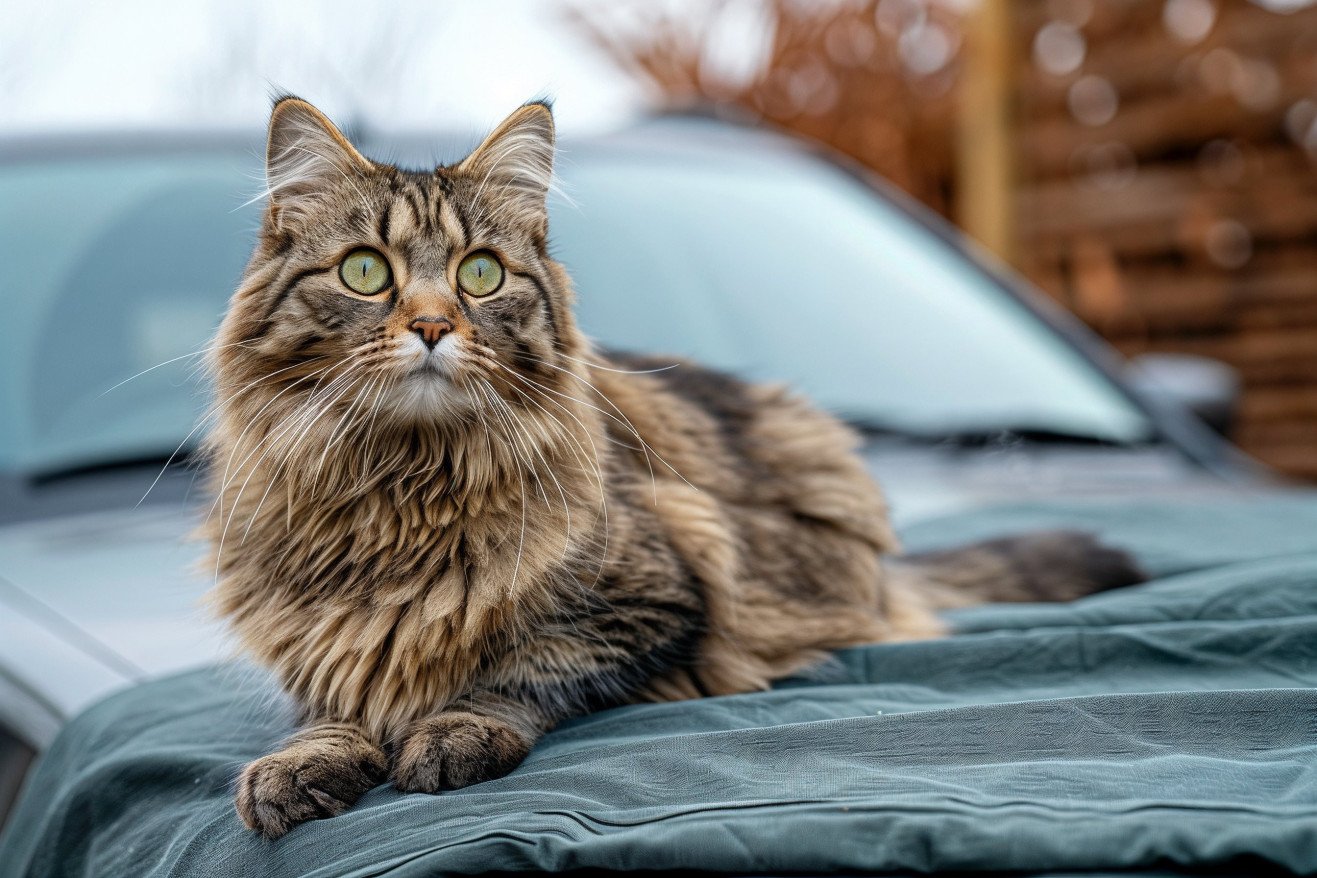How to Keep Cats Off Cars: From Science-Backed Methods to Safe Deterrents
14 February 2024 • Updated 15 February 2024

Cats love to snuggle up on the warm hoods of cars, but how can you stop them from doing so on your vehicle? Some of the best ways to keep cats off cars include using car covers, ultrasonic deterrents, and natural repellents like citrus peels.
Other options include parking in a garage and changing where you park. However, if you want to make sure you’re not harming the cats, you should avoid using toxic substances like mothballs.
To help you keep cats from climbing on your car, we’ll look at a variety of options that are based on the science of cat behavior and the design of products. We’ll also look at the latest in deterrents, evaluating their efficacy and safety, and we’ll do it all with the help of expert insights and user reviews.
Our goal is to help you find solutions that are both effective and humane, so you can keep your car in great shape while ensuring cats are safe and respectful of your property.
What are some effective methods to keep cats off cars?
Why Do Cats Like Cars?
Our Cats’ World explains that cats’ love of cars can be traced back to their ancestors, who lived in the desert.
These cats are used to living in warm climates and have a higher body temperature, which usually ranges from 100.5 to 102.5°F.
As a result, they’re more likely to seek out warm places. Cars, especially when they’ve been parked in the sun or when the engine is still warm, are the perfect place for them to find the warmth they’re looking for.
Brown Veterinary Hospital says that this behavior is comforting for cats and is the equivalent of a person wrapping themselves in a warm blanket on a cold night.
However, this behavior isn’t just about seeking out warmth. It’s also part of a cat’s natural instincts.
The Cat Bandit Blog explains that cats’ curiosity and the need for a safe place, in addition to warmth, can lead them to cars.
This is important to keep in mind when trying to deter cats from cars. It’s possible to redirect cats’ behavior by providing them with other warm places to relax or engaging in other activities that meet their territorial and exploratory needs. This information can help people come up with solutions that are more effective and humane when it comes to keeping cats away from cars.
Commercial and DIY Solutions to Cat Car Enthusiasts
The commercial market is full of products that are designed to keep cats away. For example, ultrasonic cat deterrents, according to Catsaway.org, produce a high-frequency sound that cats can hear but humans can’t.
Scat mats are also a popular option, as they have small spikes that won’t hurt cats but will make it uncomfortable for them to walk on.
If you want to take a more DIY approach, Catster suggests making your own repellent sprays with natural ingredients like essential oils and spraying them around your car. The smells of citrus peels and cayenne pepper have also been known to work as cat repellents.
In addition, an article from Tuxedo Cat notes that car covers can be a simple and effective way to keep your car safe from cats’ prying paws and claws.
Changing your parking habits, such as moving your car to a less desirable location, is a less obvious but still effective way to keep cats away.
It’s important to note that the most important thing with any of these solutions is to be consistent. Consistently using or applying these solutions will help send a message to cats and help them find other places to hang out. With time and dedication, you can make sure your car is a no-cat zone.
Assessing the Efficacy of Ultrasonic Cat Deterrents in the Field
The effectiveness and limitations of ultrasonic cat deterrents have been a topic of much discussion. Many of these devices have low ratings from consumers on Amazon. A comprehensive study in Applied Animal Behaviour Science found that ultrasonic deterrents like Catwatch© could decrease the likelihood of cat visits by about 32% and significantly decrease the time cats spent in the area.
On the other hand, a study in the Veterinary Record by D. S. Mills found only minor changes in behavior, including an increase in ear flicking and a decrease in active exploration.
A number of factors, including the location of the device and the individual cat’s behavior, may explain these inconsistent results. For example, as explained on Skeptics Stack Exchange, while ultrasonic devices may work at first, cats may habituate to the sounds and eventually ignore them.
This ability to learn and adapt is a reason to use ultrasonic deterrents in combination with other methods to ensure their continued success. A better understanding of how cats interact with their environment, especially in terms of scent, may also help identify the most effective ways to keep them away from our prized possessions.
Why Do Cats Scent Mark?
Cats scent mark as a way to communicate with other cats, and it’s a way to let other animals know that they’ve been in a particular area. According to the ASPCA, cats use scent marking to announce their presence, claim territory, and create a safe and familiar environment. Knowing this, it’s important to understand that cats are marking a vehicle to let other cats know that they’ve claimed that territory.
This means that cats are marking a vehicle to let other cats know that they’ve claimed that territory. This is why cats are often drawn back to a vehicle after they’ve marked it with their scent.
The Dumb Friends League suggests that scent marking can be addressed with a number of different strategies, including spaying or neutering, which can reduce the likelihood of marking. In addition, synthetic pheromones can be used to disrupt a cat’s chemical communication network, which can reduce the desire to mark a specific area.
It’s also important to make sure that you’re using cleaning products that are specifically designed to remove pet odors, as this is the only way to remove the scent trails that cats leave behind when they mark.
In order to successfully prevent future marking, it’s important to address the underlying causes of the behavior. Whether it’s stress, conflicts with other animals, or changes in their environment, identifying and addressing these issues can help you find a more permanent solution.
By making sure that your cat feels safe and has enough territory in your home, you can reduce the need for them to mark outside, which will help protect your car from becoming a target for feline scent marking.
Finding a Middle Ground Between Safe and Effective Cat Repellents
When choosing cat repellents, it’s important to keep in mind the safety of cats and the well-being of your car. Alley Cat Allies recommends solutions that are safe for cats and your car, including car covers and natural repellents like citrus peels and essential oils. WebMD also advises against using harsh or toxic chemicals since they can be harmful to cats and may damage your car.
Meanwhile, ultrasonic devices and motion-activated water sprinklers have received mixed feedback, suggesting that the effectiveness of repellents can vary. The Spruce Pets explains that the key to success is to use the least invasive yet still aversive options, which is in line with the LIMA principle. Cat behaviorist Mieshelle Nagelschneider says that even a small inconvenience can be enough to deter a cat after they’ve experienced it a few times.
It’s also important to use methods that are humane and in line with animal welfare. For example, products like Pet Mastermind Claw Withdrawal Cat Spray offer a mild deterrent and a pleasant human scent. In the end, the best safe and effective cat repellents will depend on expert recommendations and user reviews, which will help you find the right balance between deterring cats and keeping them safe.
Final Thoughts: Protecting Cars and Understanding Cats
As we’ve worked to better understand and solve the problem of cats on cars, we’ve covered a range of solutions from the comfort of a warm engine to the complexities of scent marking.
We’ve also seen that understanding why cats are attracted to cars is key to finding ways to keep them away. From commercial products like ultrasonic devices and scat mats to homemade solutions like citrus peels and essential oils, there are many ways car owners can keep their vehicles safe.
At the same time, it’s important to make sure that the solutions we use are safe for the cats and for the cars they’re meant to protect.
While the solutions may not always work, car owners who are consistent in their use of them and who make sure to understand cat behavior can find a way to make them effective.
As we conclude, it’s important to remember that the goal is to protect our cars and to respect our cats. With time and care, we can find ways to coexist peacefully with our pets while keeping our cars free of scratches.


